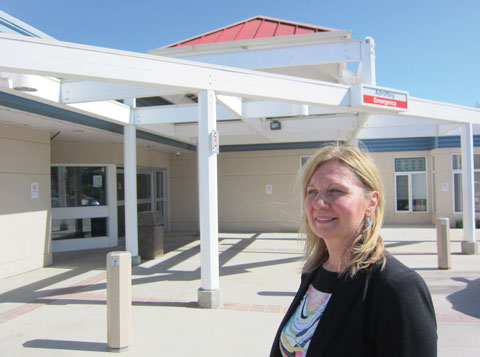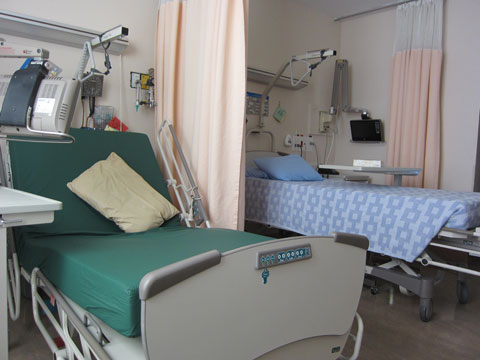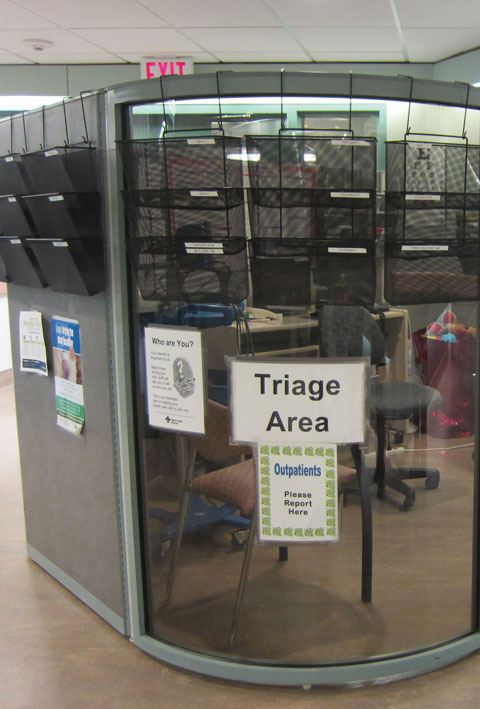Dense expanses of boreal forest, the kind that seem to attract wildfires, surround the town of Whitecourt like a wall of evergreen matches. Forestry is the traditional economic driver in this part of north-central Alberta, but the booming resource town is also flanked by numerous oil and gas installations, including pipelines that occasionally spring leaks. Long trains carrying all manner of substances, toxic and otherwise, rumble through the centre of the community, not far from the local Walmart and Canadian Tire. Trucks hauling volatile liquids regularly cross town. The four waterways that join at Whitecourt annually threaten to flood. Two years ago the Athabasca River received a massive plume of coal-mine waste from a breached containment pond.
In sum, Whitecourt is an epicentre for potential calamities, so much so that disaster response crews occasionally use it as a training ground.
Mayor Maryann Chichak has this in mind when she visits the Whitecourt Healthcare Centre, her town’s deteriorating, nearly 50-year-old hospital. She considers the facility woefully inadequate to handle Whitecourt’s everyday health needs, let alone a catastrophe.
When Chichak tours politicians and health leaders through the hospital, she highlights its long list of deficiencies, from poor ventilation and faulty plumbing to a general lack of space. She notes that the triage service is run out of a tiny booth in the middle of the main hallway. The lab area is similarly awkward. Patients waiting in their gowns for an x-ray or ultrasound must sit with other patients in a cramped corridor. A few years ago, the roof caved in over the lone operating room. There was a bee infestation. Steam from the sterilization machine sets off the fire alarm. There is no sprinkler system to deal with actual fires.

Whitecourt Hospital has many deficiencies, says mayor Maryann Chichak. (Keith Gerein)
While modern health facilities gleam with glass and steel and aesthetic appeal, the Whitecourt hospital has more in common with a Cold War bunker.
“This hospital was built when the community had roughly 2,200 people,” says Chichak, “and now Whitecourt alone has 11,000.” She speaks of unfulfilled provincial promises to rebuild the facility that date back to 1993. “We have outgrown our infrastructure… and it has really limited our ability to grow our services here.”
If Whitecourt’s hospital situation were one of a kind, that would be bad enough. In fact, it is just one of many problem facilities in the provincial hospital network. Many health facilities are plagued by excessive costs, inefficiency and crumbling buildings. Alberta’s new NDP government faces a massive conundrum: whether to scrape up the cash to refurbish or rebuild dozens of aging structures, or to shut down the most underused or decrepit.
Similar to the rotting pipes, wonky heating and malfunctioning elevators of its hospitals, the province’s infrastructure management system is equally broken. The system should be providing policy-makers and the public with a reliable process to gauge hospital conditions and set funding priorities. Instead, evidence suggests Rachel Notley’s administration has inherited a convoluted and secretive system that has made a mess of its own facility rating system. Hospital maintenance is chronically underfunded, and too often the distribution of construction dollars appears to have put political benefit ahead of community need.
Many communities in Alberta are frustrated after having been told their hospital was a priority for improvement or replacement, only to see the funding go to other projects further down the list. Some of the chosen projects were not on the priority list at all. Tony Norris, co-chairman of the Medical Services Board, a group of community leaders advocating for a new hospital in the eastern Alberta town of Wainwright, describes their situation this way: “It feels like we have been taken to the altar so many times but we never get married.”
“We’re like, ‘Okay, what decisions are being made behind closed doors that we’re missing out on?’ And nobody will answer us.”
The last great hospital-building era in Alberta was 40 years ago, when Peter Lougheed’s government constructed hospitals in dozens of small towns. A single-storey red-brick building with a sloped glass canopy was the cookie-cutter design for about 20 of the projects. It can be argued there were legitimate reasons for constructing so many small hospitals. They tended to perform more services then, and the province didn’t have the air ambulance system it has today. There is no doubt the projects also helped buy political loyalty for the PC brand.
Still, the PCs knew the loyalty would last only as long as the facilities stayed open. So, as the years passed and other provinces such as Saskatchewan and Ontario began to close low-volume hospitals, Alberta resisted doing so. The result today is that Alberta operates 97 hospitals. A total of 82 are in rural areas, including in towns of 1,000 or fewer people.
Similar to the rotting pipes, wonky heating and malfunctioning elevators, Alberta’s infrastructure management system is equally broken.
Having such a hospital stockpile costs the province in at least two ways. First, there are the ongoing operational expenses. An analysis by the Canadian Institute for Health Information estimated that Alberta spends $2,386 per capita annually on hospitals, the second-highest rate in the country and well above the national average of $1,787. This contributes to Alberta’s having the costliest health system in Canada. The abundance of hospitals is an expense with little obvious benefit. When studies are done to compare provincial hospital systems in terms of wait times, infection rates and readmissions, Alberta’s performance is about average.
Second, more hospitals means more maintenance needs. Older buildings cost more to look after than newer buildings, and the majority of Alberta’s hospitals are past their best-before date. An analysis shows about one-third are now at least 40 years old, while two-thirds are at least 30 years old—crucial milestones when major building systems need to be replaced and are at increased risk of breakdown.
Almost the only window the public has into the state of hospitals comes from facility evaluation reports periodically posted on Alberta Infrastructure’s website. The reports indicate local hospitals were generally well-constructed but are not always well looked after. They are now experiencing a growing list of problems, with the situation accelerating beyond the province’s ability to keep up. In an interview with the Edmonton Journal last year, Royal Alexandra Hospital intensivist Dr. Richard Johnston said, “The biggest frustration I have is that government has said for years that we want hospitals used 24/7, and they are. The problem is, that is not the way we maintain them.” He adds, “People come into these busy hospitals and say, ‘Why does it look like hell?’ The answer is, it may be only 20 years old in chronological time, but in use time it’s 60 years old, and that is really killing the system.”
Many common problems identified in the evaluation reports may seem minor, but they can become serious issues in a hospital setting. For example, leaky windows, cracked floors, broken sinks, soiled carpets and inadequate drainage are all breeding grounds for mould and bacteria, which can be dangerous for patients with compromised immune systems. The same can be said for facilities with poor ventilation, air conditioners and heating units. As for unreliable elevators, they are a nuisance at any time but can be crucial for staff trying to transport equipment and critically ill patients between floors.

The Whitecourt Hospital. (Keith Gerein)
Other issues are even more obviously unacceptable. Some of the more egregious examples mentioned in the reports include an ant infestation in Sundre, frozen pipes in Cardston and a nurse-call system in Bonnyville that is so unreliable that patients must use hand bells. Too many hospitals also have problems with critical safety systems, including emergency generators, electrical systems and fire alarm equipment.
While Alberta Health Services says it immediately takes care of any urgent safety risks, many leaks and creaks sit unattended for years, putting extra pressure on staff, compromising patient care and making it difficult to keep the facilities running at capacity. Age is certainly a factor in the deteriorating conditions, but so is the government’s pattern of underfunding repairs and renovations. During periods when Alberta’s finances soured, hospital maintenance budgets were cut to save money. A huge list of deferred maintenance needs is the result. The list has expanded to the point where it will now cost anywhere from $640-million to well over $1-billion to fix all the problems.
Should the province decide to rebuild many of the older hospitals, the cost will of course be greater. Reconstructing only the hospitals over 40 years old could cost as much as $8-billion.
To set funding priorities the government needs reliable information. The process that evolved under the former PC government is suspect on a number of levels. Alberta Infrastructure is responsible for the facility rating system but receives input from AHS managers and from private-sector consultants who are hired to do periodic evaluations of hospitals. Based on this input, each site is given a Facility Condition Index (FCI) score that weighs the costs of all the maintenance a facility will need over the next five years against the cost of replacing the entire facility.
For example, a hospital with a replacement value of $100-million and a maintenance bill of $18-million would have an FCI score of 18. The higher the number, the worse it is. Hospitals with an FCI below 15 are considered in Good condition. Those between 15 and 40 are rated as Fair. Hospitals with an FCI above 40 are listed as Poor. In theory, the higher an FCI score, the more economic sense it makes to replace the facility rather than spend money on extensive repairs.
The FCI scores and ratings of individual hospitals are not regularly made public. Instead, Alberta Infrastructure tends to provide a brief summary in its annual report that aggregates the condition of health facilities into one set of numbers. For the 2014/15 year, the government reported interim results that suggest 86 per cent of the province’s health infrastructure is in Good condition, 13 per cent is Fair and just 1 per cent is rated as Poor.
There are strong reasons to doubt such calculations, in part because of frequent changes in the way the province adds things up. “Improvements to methodology” make the ratings seem better while rendering year-to-year comparisons all but impossible. For example, in mid-2012 the province listed 166 health facilities in Good condition, 95 in Fair condition and 27 in Poor condition. In percentage terms, that works out to 58 per cent Good, 33 per cent Fair and 9 per cent Poor.
But instead of using those figures, Alberta Infrastructure recalculated by incorporating the physical area of the facilities into the equation. Since facilities in Good condition tended to be bigger than those with worse ratings, this boosted overall results. The new calculation resulted in Alberta’s health infrastructure being rated 72 per cent Good, 24 per cent Fair and 4 per cent Poor. Those numbers were reported to the public. Another switch saw the ministry suddenly increase the replacement value of facilities outside Calgary and Edmonton, a change defended as necessary to reflect supposedly higher construction costs in rural areas.
While the PC government defended the altered methodologies, others viewed the process as deliberately misleading. “When they fudge the numbers and come up with dramatically different results without the required investment, they are avoiding accountability for their mismanagement,” says Regan Boychuk, former research manager at the Parkland Institute and lead author of a 2013 study on past manipulations of Alberta’s rating system. Boychuk called the process “juking the stats.”

The Whitecourt Hospital’s triage is a hallway. (Keith Gerein)
The general public can get more detailed information about individual hospitals by reading the facility evaluation reports on Alberta Infrastructure’s website, but the government’s handling of these reports makes them of questionable value. For one thing, many reports are outdated, since hospitals are evaluated only once every five to seven years. Also, there is often a gap of a year or more between when reports are submitted and when they’re posted online.
A far bigger concern is that the facility evaluations from consultants (which supposedly serve as the basis for FCI scores and ratings) can be secretly disregarded by AHS or others in government if they don’t agree with the findings. Evidence for this is contained in an internal government document sent to then-health minister Fred Horne in the summer of 2012. The document provided details of health facility ratings, noting that 153 health centres and hospitals had been evaluated by consultants at that point.
However, “not all… evaluations were used to determine the physical condition of a facility,” the report reads. “Alberta Infrastructure and AHS review each evaluation to reach a consensus on the latest condition of a facility.” This wrinkle in the rating process has never been mentioned in any of Alberta Infrastructure’s annual reports.
We face a conundrum: whether to pay to refurbish or rebuild dozens of aging structures, or to shut down the most underused or decrepit.
Data included with the Horne document shows something potentially more alarming: 23 Alberta hospitals had their condition ratings secretly altered such that they deviated from their FCI score. Northern Lights hospital in Fort McMurray, for example, had its rating changed to Poor, even though its FCI of 11.65 should have placed it in the Good category. Asked for an explanation, Alberta Infrastructure said the changes were made after meetings with AHS staff who raised concerns that “the FCI did not accurately reflect the current condition of their facilities.” Asked why only the condition ratings were changed and not the hospitals’ FCI scores, the ministry said administrators felt they did not have enough information to recalculate the FCI.
An analysis of these alterations revealed interesting patterns. Of the 23 hospitals that were changed, only two saw their ratings improve, while 21 had their ratings downgraded to Fair or Poor. Of the 18 rural hospitals to receive a lowered rating, 14 were, at the time, in ridings represented by a Progressive Conservative MLA. The remaining four hospitals were in ridings with a Wildrose MLA, each of whom had narrowly beaten a PC candidate in the 2012 election.
The political divisions are of interest because one effect of lowering a hospital’s rating is that it could create a higher perception of need, thereby pushing that hospital up the list for renovation or rebuild.
There is, in fact, some evidence of this having happened. Several facilities that were downgraded, including those in Edson and Beaverlodge, have been granted a major capital project or are under consideration for construction money.
That politics might influence infrastructure funding decisions is hardly a new allegation. But the case is made stronger in Alberta by the fact that the former PC government never agreed to release a project priority list and appeared to largely ignore any kind of objective process for determining need. For instance, one might assume that at least some facilities with the worst FCI scores would be at the top of the list for funding. As it turns out, of the 10 hospitals rated to be in the roughest shape, only one—the facility in High Prairie—had a major capital project approved as of the end of 2014.
Recommendations from AHS have been similarly ignored. Of the 38 projects the health authority listed as its most urgent priorities between 2010 and 2014, the PC government approved just 13, while granting money to projects not even on AHS’s list.
For an example of how Alberta politics has been intertwined with infrastructure, one only needs to return to the case of Whitecourt. Though few would dispute that Whitecourt needs a new hospital, Mayor Chichak feels it is questionable whether Whitecourt’s needs should rank ahead of hospital needs in Wainwright, Cardston or Beaverlodge, where hospital problems are near the desperation point.
Statistics show that Whitecourt has the 15th-oldest hospital in Alberta. Though it serves a growing community, close to half the beds are empty on an average day. AHS does not include Whitecourt on its list of most pressing infrastructure priorities. Despite that, Whitecourt has been rated the frontrunner for construction funding. In 2012 Mayor Chichak was the Wildrose candidate in a very close race against veteran PC incumbent George VanderBurg. In the final days of the campaign, then-premier Alison Redford vowed to make Whitecourt the top priority for Alberta’s next rural hospital project—a vow many believe helped VanderBurg eke out a 368-vote victory. At some point that year, the Whitecourt hospital was one of the facilities to have its ratings secretly downgraded to Fair despite a strong FCI score of 4.74.
Before the Prentice government was ousted, it confirmed Whitecourt’s place at the top of the list, but did not manage to get any shovels in the ground. The project’s fate now rests with the new NDP government.
Rachel Notley’s crew have made a few encouraging moves toward cleaning up the infrastructure management process. The government has indicated it will substantially increase the budget for maintenance. Infrastructure minister Brian Mason has said he will introduce a project “sunshine” list so everyone can see the province’s funding priorities. The auditor general is also expected to release a report on the topic.
It is yet unclear if any of these moves will make real progress toward fixing Alberta’s costly and inefficient hospital system. To accomplish that, more dramatic decisions will likely be needed, such as closing some of the lowest-volume hospitals and shifting those resources to overburdened centres.
The NDP government “is in a terrible dilemma,” says Donna Wilson, a University of Alberta nursing professor who has studied hospital trends. “They are going to have to make the tough choice: Either you rebuild these hospitals or you refocus. It’s a delicate balance, because people are afraid they aren’t going to get the healthcare they need.”
Keith Gerein works at the Edmonton Journal, where his series on Alberta hospitals was a 2014 National Newspaper Award finalist.

